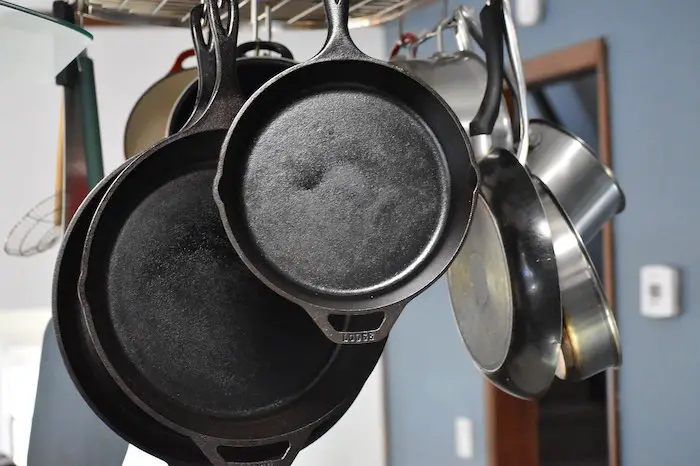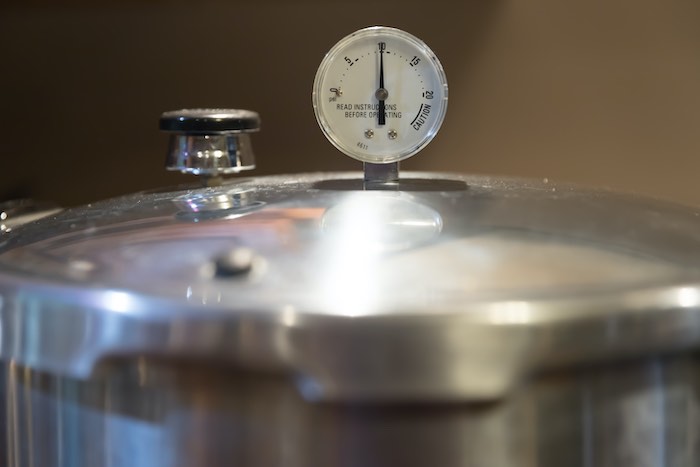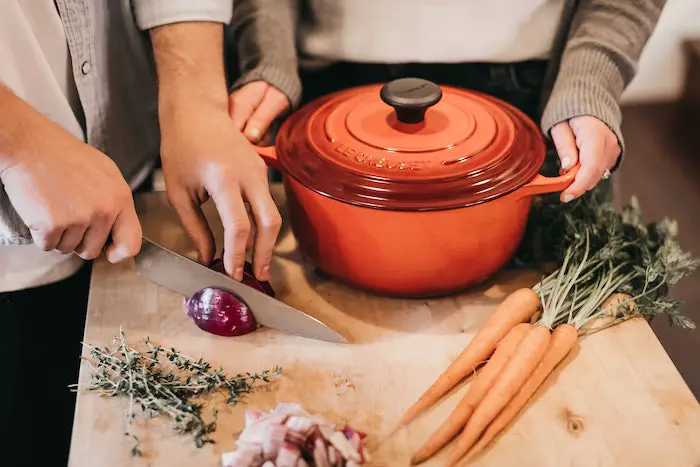When we talk about cast iron versus regular pans, some people have a little confusion over how they deviate from one another. While there are some distinct similarities, there is also a world of difference between them, setting cast iron apart from other pans in this classification of cookware.
The main difference between a cast iron skillet and a regular pan is their materials. Cast iron is comprised of iron, whereas regular pans are often stainless steel or aluminum. You can make almost anything in a cast iron skillet and use it both on the stovetop or in the oven. Usually, standard frying pans are only good for use on the stovetop.
Unfortunately, when you’re reading a recipe, they don’t usually indicate which one you should use. Therefore, understanding the difference between cast iron and regular pans is fundamental knowledge that will greatly affect the food you prepare.
Comparing Cast Iron vs. Regular Pans
| Cast Iron | Regular | |
| Materials | Iron | Aluminum, stone, stainless steel, or ceramic-coated with a nonstick substance |
| Shape | Angled sides that are tall | Varying shapes |
| Oven and/or Stove | Both oven and stove | Stove only |
| Ideal Uses | Roasts, stews, casseroles, frittatas, sauces, sautéing, frying, baking, grilling, broiling | Frying, browning, searing, sautéing, stir frying, sauces |
| Lifespan | For an entire lifetime | Depending on the quality, a few years to seven years |
| Healthiness | Rather healthy but can rust, which can cause several health problems | Not as much need for oil or butter, but the coating can present issues |
| Ease of Care | Difficult | Easy |
Cast Iron Skillets
Cast iron skillets are hugely popular and give a meal a home-style ambiance. However, there is a learning curve to using them, and you actually have to take care of them too. This means that they’re not easy to clean, and you also have to keep them “seasoned.” The massive benefits, though, are that one cast iron skillet will last you a lifetime and their effectiveness improves with use as well.
Weight & Shape
Cast iron skillets tend to be heavy and cumbersome. Even smaller ones have quite a bit of weight to them, which can make them difficult for some people to use. The sides slant downward, resulting in a more narrow area for cooking. However, this feature also allows you to reach food easily and stir it around without it falling outside the pan.
Design & Manufacturing
The design, engineering, and material of a cast iron skillet are naturally non-stick, but these pans also require consistent seasoning by applying baking oil onto the cooking area of the pan’s surface. This provides a layer of protection. Without it, the danger of consuming bits of iron increases, which can present certain health issues if you’re not careful.
On a positive note, there are no synthetic coatings added to a cast iron skillet during manufacturing, so when used properly, these can provide a very healthy meal that doesn’t leech harsh chemicals into the food during the cooking process.
Heat Retention & Use
Iron is notorious for being able to retain heat. While it does take the pan some time to warm up, once it gets going, it keeps that way for quite a while. However, it does take a long time for the pan to cool down, meaning the handle can get scalding hot and you can severely burn your hands even after the pan has been removed from the heat for a while.
Some recipes call for cooking items on the stove and then transferring them to the oven to finish them off. In these cases, the cast iron skillet is ideal for this technique.
Care & Maintenance
The care and cleaning of cast iron pans is where the real trouble comes into the picture. These pans, at some point, will begin developing rust, and this can cause numerous health problems.
Regular Pans
Everyone knows what a regular pan is: it’s one of the most common pieces of cookware in anyone’s home. These are quick and easy for fast stovetop cooking. These come in a vast array of materials, sizes, and shapes. Sometimes, they can be square; other times, they’re round. The sides can come rounded, straight, or angled.
Cost & Manufacturing
Regular pans can be either affordable in their common varieties, or you can also purchase the expensive, chef-grade kinds. One issue with these pans though is that they often have a chemical coating on them that can be the precursor to plenty of health problems. These include things like cancer, heart disease, tumors, and more. There are now some coatings used that are much safer, but you must intentionally look for this particular feature when buying one.
Maintenance & Lifespan
Regular pans are often nonstick, making them also easy to keep clean. You can clean them in the dishwasher or just use some soap and water. Regular pans also make food a little healthier, since you don’t need a lot of oil or butter to prepare your food when using them.
Unfortunately, these pans don’t last very long, and they also tend to warp, chip, and fade with time and regular use. Additionally, some cheaper or older pans will heat food unevenly, and this can leave much to be desired when you’ve finished a cooking meal and it hasn’t turned out just right.
See Also:
Can You Put Enameled Cast Iron In The Oven?
4 Best Cooktops With Wi-Fi
6 Best Cast Aluminum Patio Furnitures
Oligo Syrup Vs. Corn Syrup: Here Are Differences


